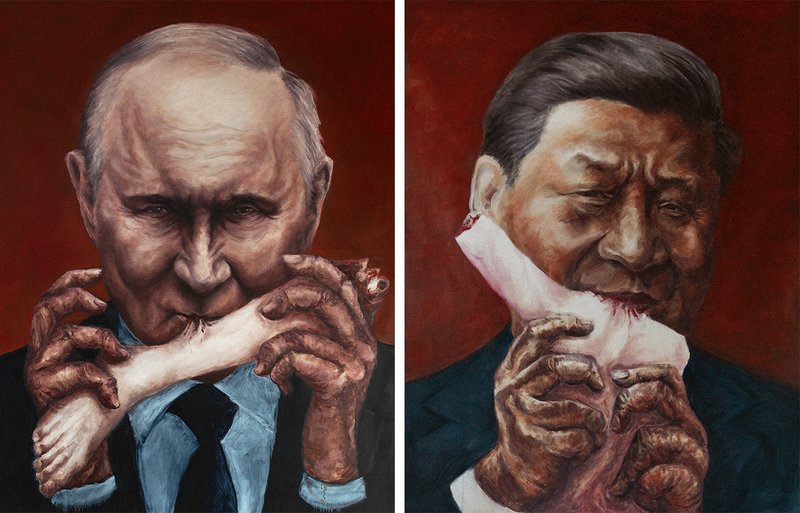NAVA defends Badiucao’s exhibition against censorship by Chinese government
and Naomi Segal
and Naomi Segal

Badiucao, 'Devouring Children No. 1' and 'Devouring Children No. 2' 2023. Oil on canvas.
[ID: Two portrait format paintings, one of Vladimir Putin, President of Russia and the other of Xi Jinping, President of the People's Republic of China. They are each depicted eating the flesh off small dismembered limbs. They are wearing dark suits and ties, the background is deep red in each painting.]
The National Association for the Visual Arts (NAVA) defends Chinese-Australian artist Badiucao and his upcoming exhibition Tell China’s Story Well. Scheduled to open this Friday in Poland, the exhibition has received pressure from the Chinese embassy in Warsaw to be shut down.
Badiucao’s work contains critical insights into the Chinese Communist Party’s human rights violations, including the cultural assimilation of Uyghur people, censorship inflicted on Chinese citizens throughout Covid-19, and the crackdown on protest and press freedoms in Hong Kong. The title, Tell China’s Story Well, references President Xi Jinping’s public diplomacy strategy of promoting a positive national image.
NAVA is a strong advocate for freedom of expression and asserts that censorship should not be used to constrain artists from exercising this right within the law.
Freedom of expression is the right to create and distribute cultural expressions without governmental censorship, political interference, or the pressures of non-state actors. The freedom of opinion under Article 19 of both the Universal Declaration of Human Rights and the International Covenant on Civil and Political Rights (ICCPR) is an absolute right, not subject to any interference. Article 19 of the Universal Declaration also promises protection of the right to seek, receive and impart information and ideas through any media, while Article 19(2) of the ICCPR expressly provides that the right includes expression ‘orally, in writing or in print, in the form of art, or through any other media’.
Artistic freedom enables artists to expose and analyse the complex socio-political and cultural urgencies we live in. Artistic freedom is integral to accountability and equity, as it allows artists to critique systems of injustice and propose alternatives. This freedom must be upheld.
NAVA has written to the Minister of Culture and National Heritage calling on Prof. Piotr Gliński and the Polish government to support the continuation of Badiucao’s exhibition, Tell China's Story Well, against censorship from the Chinese embassy in Warsaw. NAVA also calls on the Polish government to take measures to ensure the safety of Badiucao during their time in Poland.
NAVA sets out freedom of expression good practice recommendations in its Code of Practice for Visual Arts, Craft and Design.
About the exhibition
The title of the exhibition refers to China’s public diplomacy strategy. The phrase, introduced by President Xi Jinping within the first year of his administration, in August 2013, served as an encouragement to Party-state media, and even quasi-private actors, to promote official Chinese views and opinions and thus strengthen the country’s international influence.
Badiucao’s art of protest is telling a different story. A story of ongoing human rights violations, the manipulation of historical memory of the 1989 Tiananmen Square events, censorship inflicted on Chinese citizens during the Covid-19 pandemic, forced cultural assimilation of the Uyghurs, protests in which Hong Kong residents fought to oppose government policy, and the disturbing relationship between China and Russia in light of the war in Ukraine.
At the same time, the exhibition pays tribute to all those, who, like Badiucao himself, have felt they had a duty to stand up and speak out against any form of injustice. Those, who, despite great risks, have had the courage to raise their own voice and tell their own story.
Media enquiries
Leya Reid media@visualarts.net.au